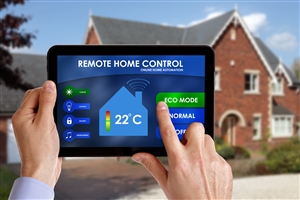 As we take a broad look at the Internet of Things (IoT) this week, I wanted to take a deeper look at how the IoT will deliver a smarter grid (and visa versa) to enable more information and connectivity throughout the infrastructure and to homes. Through the IoT, consumers, manufacturers and utility providers will uncover new ways to manage devices and ultimately conserve resources and save money. Let’s take a look at how smart meters are being implemented worldwide to connect the smart grid to your homes.
As we take a broad look at the Internet of Things (IoT) this week, I wanted to take a deeper look at how the IoT will deliver a smarter grid (and visa versa) to enable more information and connectivity throughout the infrastructure and to homes. Through the IoT, consumers, manufacturers and utility providers will uncover new ways to manage devices and ultimately conserve resources and save money. Let’s take a look at how smart meters are being implemented worldwide to connect the smart grid to your homes.
With the global focus on energy management and conservation, the IoT will extend the connected benefits of the smart grid beyond the distribution, automation and monitoring being done by utility providers. Management systems for in-home and in-building use will help consumers monitor their own usage and adjust behaviors. These systems will eventually regulate automatically by operating during off-peak energy hours and connect to sensors to monitor occupancy, lighting conditions, and more. But it all starts with a smarter and more connected grid.
The first key step towards a smart grid that makes the IoT real is the mass deployment of smart meters. Millions of meters are already connected today and the connected grid momentum is growing. However, to obtain its maximum potential, the first step for the smart grid is to transition from mechanical meters to smart electronic meters to establish two-way communication between the meter and utility providers.
The adoption rate of smart electrical meters in the U.S. is close to 50 percent with millions of electrical meters deployed today in the field, connected to the grid and regularly communicating data. Essentially, electrical meters are extending their functions from an energy measuring device to a two-way communication system.
Modern e-meters must meet certain criteria to play such a critical role in the smart grid and IoT. First, meters need to report energy consumption information from houses and buildings back to the utilities. In the U.S., the appropriate solution is low power RF (LPRF) communication using a Sub-1 GHz mesh network. However, depending of the country and the nature of the grid, a wireless solution might not be the best choice, for example in Spain or France where wired narrowband OFDM power line communication (PLC) technologies are used. There is no one connectivity solution that fits all deployments. Making the IoT real requires a larger portfolio that can go from wired to wireless and sometimes combined together.
Second, the meter needs to deliver useful power consumption information into the home through an in-home display or a gateway. This information allows consumers to adapt energy behavior and lower utility bills. In the U.S. the ZigBee standard is being used in combination with Smart Energy application profile. Other countries such as the U.K. or Japan are evaluating Sub-1 GHz RF or PLC solutions for greater reach or a combination implementation with both hybrid RF and PLC. So in essence, electrical meters are becoming smart sensors for the IoT that communicate both ways, inside and outside homes and buildings, connected to each other in a mesh network while reporting essential energy data to utilities.
Additionally, a smart meter needs to support advanced functions like dynamic pricing, demand response, remote connect and disconnect, network security, over-the-air downloads and post-installation upgrades so utility providers don’t have to send out technicians to each meter.
As you can see, the smart grid plays a critical role in supporting the IoT – but it’s just the beginning. Connecting devices together in building and homes is one of the next steps to reach the full benefits of the smart grid and many innovative solutions and convenient applications are already offered to the consumers. The introduction of dedicated home energy gateways, smart-hub or energy management systems will greatly accelerate connected grid and IoT benefits for consumers. For more information, read this whitepaper to learn how TI is creating a smarter grid with the Internet of Things.
Learn more about TI’s IoT capabilities in these blog posts featured during #IoTWeek:
- The Internet of Things – A world of possibilities on ConnecTIng Wirelessly
- Multiple screens, five happy passengers, and one peaceful driver thanks to the connected car on Behind the Wheel
- How the Internet of Things has finally arrived on Think. Innovate
- The energy required for your Thing just got lower…much lower on Fully Charged
- Make big IoT plans without the burden of a big power budget on The Official MSP430 Blog
- Trends in building automation technology on Tools Insider
- Making it easier to connect more to the IoT on ConnecTing Wirelessly
- Simple gifts: Reaping big from a tiny harvest on Analog: The real world
- The promise of the Internet of Things: Proliferating sensor nodes on Analog Wire
- Cloud architecture evolves: Part 1 - Enter the second phase and a better way to cloud on the Multicore Mix
